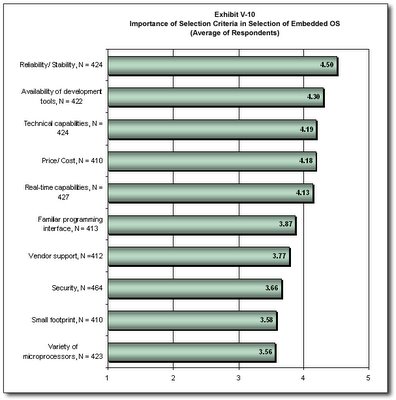Concurrent has been emphasizing is software offerings recently:
- Reseller dealer withNovell to jointly sell and support Concurrent Real-Time Extensions Powered By SUSE Linux, a specialized Linux offering based on Novell's popular SUSE Linux operating system. (Jan 2006)
- Nighthawk development tools released to merchant market (Nov 2005)
- Several design wins for RedHawk RT Linux (2005/2006)
Additionally, we achieved higher overall gross margins partly due to our continued evolution to a software company. These operating results combined with the anticipated growth of both the video-on-demand business and our real-time operating system business indicate improving results in calendar 2006. Our enthusiasm is due to the huge growth in content availability for VOD, the success of near network DVR applications like "Start Over," and our recent announcement of a partnership with Novell to sell our real-time Linux operating system on the SUSE Linux release. Our real-time Linux operating system continues to gain momentum as the best high performance operating system in the market. We anticipate growing revenues in the coming quarters which, coupled with sound fundamentals, should tend toward positive results."
The financial info is below
ATLANTA, Georgia, January 27, 2006 - Concurrent (Nasdaq: CCUR), a worldwide leader of on-demand and real-time computing technology, today announced its results for the second quarter of fiscal year 2006.
In the second quarter of fiscal 2006, consolidated revenue for the company aggregated $18.9 million compared to $16.2 million in the first quarter of fiscal 2006, an increase of 16.3%. Revenue from Concurrent's on-demand product line totaled $9.8 million for the second quarter of fiscal 2006 compared to $7.3 million in the first quarter of fiscal 2006, an increase of 33.7%. Revenue from the company's real-time product line totaled $9.1 million for the second quarter of fiscal 2006 compared to $8.9 million in the first quarter of fiscal 2006, an increase of 2.1%. Cash at the end of the second quarter of fiscal 2006 totaled $17.0 million, a decrease of $0.4 million from the prior quarter.
The net loss for the second quarter of fiscal 2006 was $1.6 million, or a loss of $0.02 per fully diluted share, compared to a net loss of $2.2 million, or a loss of $0.03 per fully diluted share, in the first quarter of fiscal 2006.





